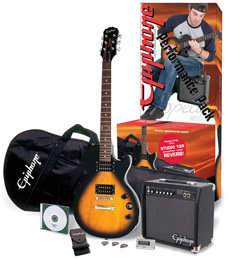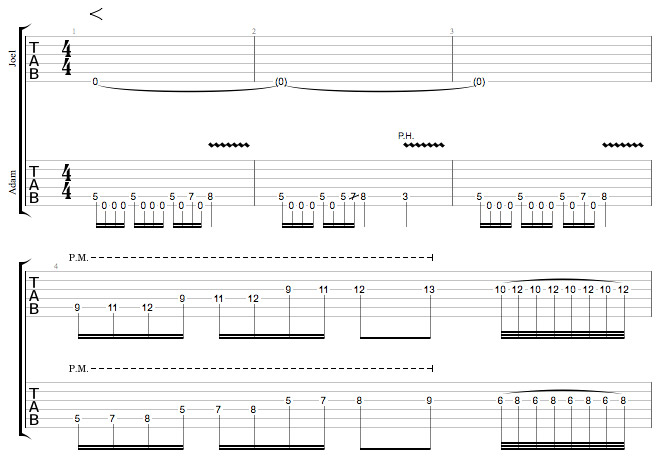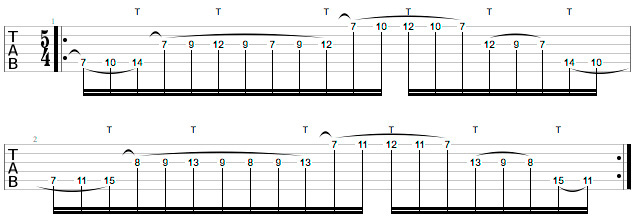Welcome back! In Part 1 of this article, we looked at various considerations and research tips to guide your search for the right guitar. Now we will get into specifics with price ranges, accessories, and upgrade possibilities.
Price Ranges/Value Packs
Here are some guitars that fall into different price ranges for a beginner on a budget:
$100-250 – Epiphone Les Paul Special, Ibanez RG120, Squier Telecaster Special, Squier Stratocaster Special, Dean Vendetta XM.
In this price range, it’s best to go with a value package. Squier and Epiphone (the cheaper overseas companies for Fender and Gibson, respectively) offer great value packs that come with an electric guitar, practice amp, instrument cable, electronic tuner, guitar stand, gig bag, assortment of picks, and an instructional DVD. You definitely get your money’s worth with these value packs and these are great for diving right in with lessons.
The downside to these value packs is the quality of the guitars. For example, there is a significant difference between a Fender Strat and a Squier Strat in terms of playability and quality. If you start with a Squier, you will most likely outgrow the instrument in six months to a year. These are good for starting out but won’t give you much in the long run.
$250-300 – Jackson JS32T Rhoads, Ibanez ART100, Dean Dave Mustaine V VMNTX Signature, ESP LTD Viper-100FM, Peavey JF-1 Hollowbody, ESP Kirk Hammett Junior.
There are more guitars to choose from in this price range, and most are fairly decent – with some modification down the road, you can probably get a lot of mileage out of them. Companies who make artist signature models often offer the cheapest version of the model in this price range. Signature models can be fun and inspiring to a young player who dreams of mastering the styles of their heroes along the path to developing their own style.
$300-500 – Fender Standard Stratocaster, Epiphone Les Paul Standard, Fender Blacktop Jaguar HH, Schecter Damien 6, ESP LTD Alexi-200 Alexi Laiho Signature, Epiphone Limited Edition 1966 G-400 Electric Guitar and All Access Amp Pack.
This is a great price range! Here, the guitars are well made, not too tough on your wallet, and will last for a long time. There are still some value packs offered, like the Epiphone G-400 Guitar and Amp pack. If you get a guitar in this price range, then separately buy an amp and accessories, you will be spending around $800. This is more of an investment, but the quality will last you through the years, and there is an opportunity for upgrades in the future. This saves more money in the long run. There is one guitar in this price range that I recommend above all other guitars…

Mexican Strat
MY ULTIMATE RECOMMENDATION
The Mexican-made Fender Standard Stratocaster. Mexican Strats are cheaper than their American counterparts, but they still sound and play great. I know many musicians, including myself, that started out on Mexican Strats and they served them well for years.
The Stratocaster’s popularity comes from its playability and versatility. You can achieve many different tones and sounds with the Strat: the bridge single coil pickup is great for a distorted blues and rock sound, and the warm neck pickup is great for softer rhythm playing and even jazz tones. Basically, any sound you want, you can get with a Strat. It’s also light and comfortable to play while sitting.
Amplifiers
If you decide to go electric, you’ll need an amp. An amp is as instrumental in shaping a players sound as the guitar itself. Despite that, for a beginner, it’s more important to have a good guitar than having the perfect sounding amp, since you interact directly with the guitar.
With budget in mind, practice amps are great for beginners because they are portable and relatively inexpensive. You probably wouldn’t want to play a gig with a practice amp, but they can suffice in your early days as a guitarist. Marshall, Peavey, Vox, and Fender make excellent practice amps. The Roland Micro Cube is another great practice amp that is battery operated. It only costs around $130.00 and can actually get pretty loud. If you are on a tight budget and don’t want to disturb the people you live with, try out the Vox Amplug AC30 Headphone Amp which runs for about $50.00. This small amp plugs directly in your guitar and lets you plug in headphones, which is very good for solo practice and developing a critical ear.
Down the road, you will want to upgrade to either a half stack, which consists of a head that contains the engine of the amplifier and a separate speaker enclosure called a cabinet, or a bigger version of a combo amp, which combines a speaker cabinet with a head. Common configurations for guitar amp cabinets include 2X12, meaning two 12-inch speakers, and 4X10, meaning four 10-inch speakers. Fender’s famous combo amplifiers, such as the Twin Reverb, and an excellent choice for jazz or blues and even lighter rock tones, while Marshall’s powerful half stacks have long been a favorite of rock and metal players. Many other companies, such as Mesa/Boogie, Orange, ENGL, Bogner, Diezel, Framus, Vox, Dr. Z and Matchless make excellent amplifiers for rock, metal, blues and country players, as well. When you are ready to step up to a more professional amplifier, be sure to research and play as many models as possible, in the same way you shopped for your guitar.
Accessories And Effects
Picks, strings, tuners, cables, and straps – these guitar accessories are essential, but again, you have many choices in each category, so experiment and find the versions that suit you best. As you progress as a guitarist, try experimenting with different strings, pick sizes and thicknesses. To start out, I’d recommend a pick with about 1mm thickness. This will ensure a solid connection with the string without the pick bending.
For strings, try a light gauge at first, to make the initial process of developing calluses on your fingertips less painful. There are many string brands and gauges out there, so don’t be afraid to try different sets out. Perhaps buy a variety of strings and switch them every month or so to see what works best for you. Brands like Ernie Ball and D’Addario are old favorites, and if you find that your strings wear out quickly, you may want to try coated strings, such as Elixir’s Anti-Rust line.

Korg CA-40
A great tuner to start out with is the Korg CA-40 Chromatic Tuner. It is basic and has an easy-to-read interface. You can plug your guitar directly into the tuner or have its microphone pick up the guitar sound in the room. Plus, it’s relatively cheap at around $18.00.
Though you may eventually want to have cables in a variety of lengths, a single 10-foot cable by a company like Fender, Planet Waves or Monster is a great place to start.
Straps come in a wide variety. Find one that you think looks cool and is comfortable. Levy straps are the most abundant guitar straps on the market.
Guitar effects are often expensive and are not essential for starting out. Once you advance, you may want to invest in either a multi-effects processor or individual pedals. Common effects are distortion, digital delay, reverb, phase-shifter, flanger, wah, and whammy pedals. Boss, Line6, and DigiTech are all great brands for multi-effects units, and Dunlop/MXR, Boss, along with boutique companies like Analogman and Electro-Harmonix make quality single-effect pedals. One danger of using effects is their potential for developing laziness in a guitarist’s playing. Young players who use a lot of effects early on can become so enchanted with the sounds coming from their amp, that they lose the motivation to enhance their guitar skills. Effects are exciting, but it’s better for a new player to focus on developing good technique before becoming immersed with effects.
Expandability/Upgrades
I’d like to share my guitar-owning experience with my main guitar, the Fender Stratocaster, to illustrate the potential for expandability and upgrading that can save you a lot of money.
I began playing guitar when I was 13 and ended up buying an Ibanez with a Floyd Rose tremolo system. The guitar looked awesome, but the Floyd Rose became problematic to keep in tune. I went back to the store and exchanged the Ibanez for a Mexican Fender Strat thanks to the recommendation of a salesman. The Fender has been my main guitar for ten years.
Although I wanted to indulge my senses and dreamed of owning a Gibson Les Paul Custom or a Paul Reed Smith McCarty hollow body, the price tags on those guitars were simply too much and I decided to make some upgrades. In retrospect, I am happy I stayed with my Strat because it became an integral part to my sound and individuality as a guitar player. The quality has held up over the years and overall, I’ve been very happy with it.
After I moved on from playing alternative rock and grunge to metal, I knew the Strat’s single coil bridge pickup didn’t offer the fatter distorted tone needed for heavier music. I purchased a Seymour Duncan humbucker and had it professionally installed at a local music shop. This gave me a heavier sound and cost me much less than buying a new guitar with more metal characteristics.
I also upgraded amplifiers and that really changed my sound for the better. My starter amp was a Peavey 112 Transtube amp (a low-cost solid state amplifier that simulates the sound of a more expensive vacuum tube amp.) It was decent enough to get me through years of practicing, recording, and live performances, but I got tired of the amp’s saturated distortion and wanted a more organic sound. I did some research and settled on an Orange Tiny Terror Combo Tube amp. What a difference! I finally got the power, grit, and volume I had always wanted. The combination of my modified Fender and Orange amp gives me a great sound that actually works for metal.
Upgrades, modifications, and the expansion of your rig are all developments in a player’s voice. A guitarist’s sound becomes the result of practice and experimention. You don’t have to buy the most expensive guitar to sound good and become a killer guitarist.
Closing
As you can see, there are many factors that go into purchasing your first guitar. It can be a lot to think about, but the most important thing to remember is to find a guitar that will inspire you and keep you excited about playing music.
Although guitars come in many sizes, shapes, and colors, it is ultimately the player who brings the guitar to life. After you purchase your first instrument, you are one step closer to becoming a great guitarist. Have fun and keep practicing!
















